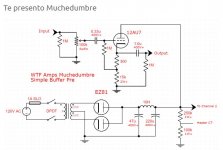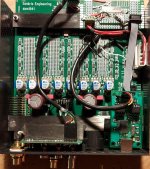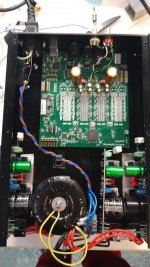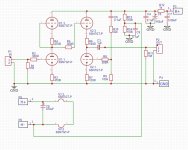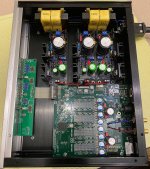How does it work outside the case ? Check that the connector pins don't get shorted by the case, can happen if the board are mounted too low....
And check the area around U72 for shorts or bad soldering, the AES, BNC and RCA all goes though that RD422 receiver....
And check the area around U72 for shorts or bad soldering, the AES, BNC and RCA all goes though that RD422 receiver....
Last edited:
dam1941 plug-in module
I am happy to show the plug-in module, based on the eminent OEM line 1941 board.
This module is the latest in a series of various modules together forming a flexible audio system. Currently there are modules as 96/24 resolution DSP, IP- and USB recievers and an ADC. All modules work as plug-n-play to a 2-way I2S backbone bus.
All modules are housed in a standard carbon-fibre composite box which properties are strength, low-weight and RFI-resistence.
This DAC has a balanced analog output, straight from resistor network and aimed to drive a fully balanced earspeaker amp, using the re-introduced low-noise jfet LSK389 dual in the input stage. Linear Systems Reintroduces LSK389 Ultra-Low Noise N-Channel JFET | audioXpress
The 1941 board, which here replace the dam1121 board is the pinnacle of Soekris production so far.
Imgur: The magic of the Internet
I am happy to show the plug-in module, based on the eminent OEM line 1941 board.
This module is the latest in a series of various modules together forming a flexible audio system. Currently there are modules as 96/24 resolution DSP, IP- and USB recievers and an ADC. All modules work as plug-n-play to a 2-way I2S backbone bus.
All modules are housed in a standard carbon-fibre composite box which properties are strength, low-weight and RFI-resistence.
This DAC has a balanced analog output, straight from resistor network and aimed to drive a fully balanced earspeaker amp, using the re-introduced low-noise jfet LSK389 dual in the input stage. Linear Systems Reintroduces LSK389 Ultra-Low Noise N-Channel JFET | audioXpress
The 1941 board, which here replace the dam1121 board is the pinnacle of Soekris production so far.
Imgur: The magic of the Internet
You can also reduce the output level with no side effects by a resistor from output to ground, the direct resistor networks output is a voltage source with 625 ohms output impedance....
This was something that was on my mind after owning the dam.
Recently in the other thread there was a discussion about digital and analogue attenuation , specifically brought up in relation to the soekris DACs.
Neither are perfect so it comes down to preference, but that's not important now... absolutely no one mentioned using a resistor on output to ground like this for soekris DACs, but as you say it should work with no side effects since the DAC's output is resistive... if you used a rotary switch to select the resistor it seems like you would have an ideal (lossless) attenuator, which is only possible with this DAC.
Is it just that no one really cared that much to make a custom attenuator (since the digital atttenuation is very good and simple solution) or there is some slight negative effects to loading the output like this?
Last edited:
Hi Soren and all,
Its OK, when i connect on output 1941 in parallel mode (313Ohm) capacitive load about 1,6nF?
Jan
Its OK, when i connect on output 1941 in parallel mode (313Ohm) capacitive load about 1,6nF?
Jan
Hi Soren and all,
Its OK, when i connect on output 1941 in parallel mode (313Ohm) capacitive load about 1,6nF?
Jan
You can connect anything, just remember to calculate the results.
You can connect anything, just remember to calculate the results.
At the maximum output voltage from the DAC (1.83Vp) at 20KHz, the current through the load capacity of 1.6nF is about 0.4mA. Is the DAC able to deliver this current without signal distortion?
Very nicely doneA picture of my solution with Salas ultrabibs triplet. Works really fine 🙂
And this is my just finished dam1941, with Salas triplet too and display board (short version, w/o headphone and volume section).
It was pure joy to assembling all during last few weeks and I’m especially proud on my still hands and good eyes to solder tiny smd chips on dsp board.
I set parallel mode in uManager, and wired together + and – pins to use direct unbalanced outputs. I don’t like any CF, transformers, etc.. and connect dam directly to my new toy for next few weeks: dht preamp STC 3A/141A
All working perfectly from the start with nice refined and full integrated sound, from top to bottom. For sure this project is highly recommended from my side, with very good sound for money ratio. Thank you Søren, Salas, Teabag and all others from our DiyAudio community.
It was pure joy to assembling all during last few weeks and I’m especially proud on my still hands and good eyes to solder tiny smd chips on dsp board.
I set parallel mode in uManager, and wired together + and – pins to use direct unbalanced outputs. I don’t like any CF, transformers, etc.. and connect dam directly to my new toy for next few weeks: dht preamp STC 3A/141A
All working perfectly from the start with nice refined and full integrated sound, from top to bottom. For sure this project is highly recommended from my side, with very good sound for money ratio. Thank you Søren, Salas, Teabag and all others from our DiyAudio community.
Attachments
Looking nice and clean pecci, congrats.
I see you have the same heatsink for the 3 UltraBiB, do you find it adequate for the Digital UltraBiB?
From the picture I see you have connected the ladder Positive and GND to the output did you jumper the negative underneath?
I see you have the same heatsink for the 3 UltraBiB, do you find it adequate for the Digital UltraBiB?
From the picture I see you have connected the ladder Positive and GND to the output did you jumper the negative underneath?
- Home
- Vendor's Bazaar
- dam1941 - Next Gen Discrete R-2R Sign Magnitude 24 bit 384 kHz DAC module
